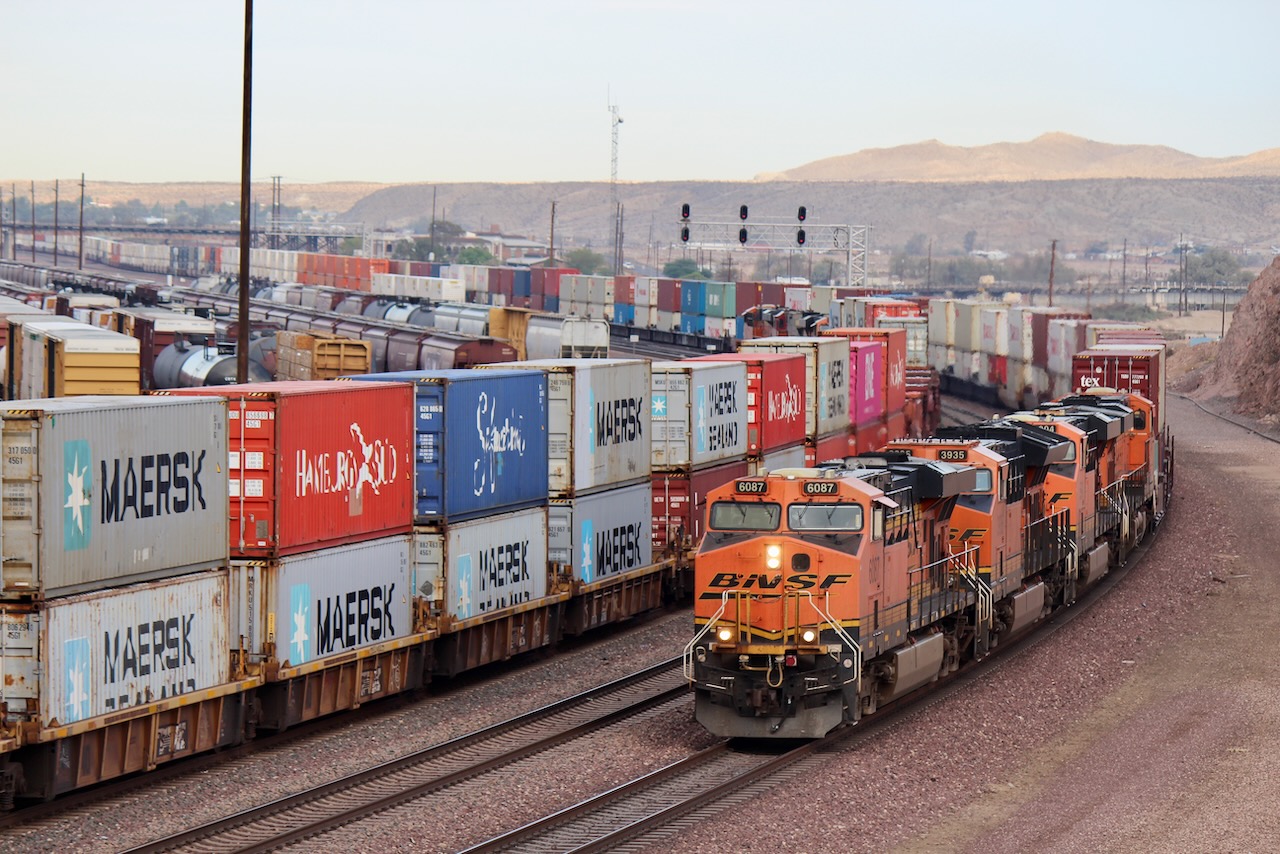
BARSTOW, Calif. — BNSF Railway has announced plans for what it is calling the first master-planned rail facility built by a Class I railroad — costing more than $1.5 billion and including a rail yard, intermodal facility, and warehouses for transloading from international to domestic containers.
The Barstow International Gateway, to be on the west side of the community in the Southern California desert, already the site of a major BNSF yard and shop facility, will cover approximately 4,500 acres. Containers will be transferred directly from ships to trains which will bring them to Barstow, where they will be processed and built into trains moving east. Trains arriving from the east will be similarly processed for cargo movements to the ports.
BNSF CEO Katie Farmer said the facility “will maximize rail and distribution efficiency regionally and across the U.S. supply chain and reduce truck traffic and freeway congestion in the Los Angeles Basin and the Inland Empire,” and improve operations at existing intermodal hubs in the Midwest, Texas, and elsewhere. Port of Los Angeles Executive Director Gene Seroka said the project will “improve cargo velocity through our port” and “help ensure that goods moving through the San Pedro Bay will get to consumers, businesses, and manufacturers with speed and reliability.”
BNSF also says the new facility will directly and indirectly create 20,000 jobs.
“Projects like BNSF’s will work to strengthen our inland local economies,” said Treyland Bradley, deputy director of sustainable freight and supply chain development at the Governor’s Office of Business and Economic Development. “We look forward to continuing to work with projects like these, as well as others, to drive transformative investments that will enhance and elevate California’s supply-chain ecosystem for a more efficient and resilient tomorrow.”
BNSF’s announcement offers no indication of a timeline for either the beginning or completion of the project, and does not indicate any customers have committed to the project, saying only that “we are always in discussion with current and future customers.” There is some additional information at the Barstow International Gateway Project website.
This is the second major project announced in a matter of weeks that seeks to move LA and Long Beach port traffic by rail to an inland location for further processing. In mid-August, private developers detailed plans for the Mojave Inland Port, a 410-acre facility to be served by Union Pacific [see “Plans advance for Mojave Inland Port …,” Trains News Wire, Aug. 15, 2022]. That facility aims to handle up to 3 million containers per year and says it could support as many as 3,000 new jobs.






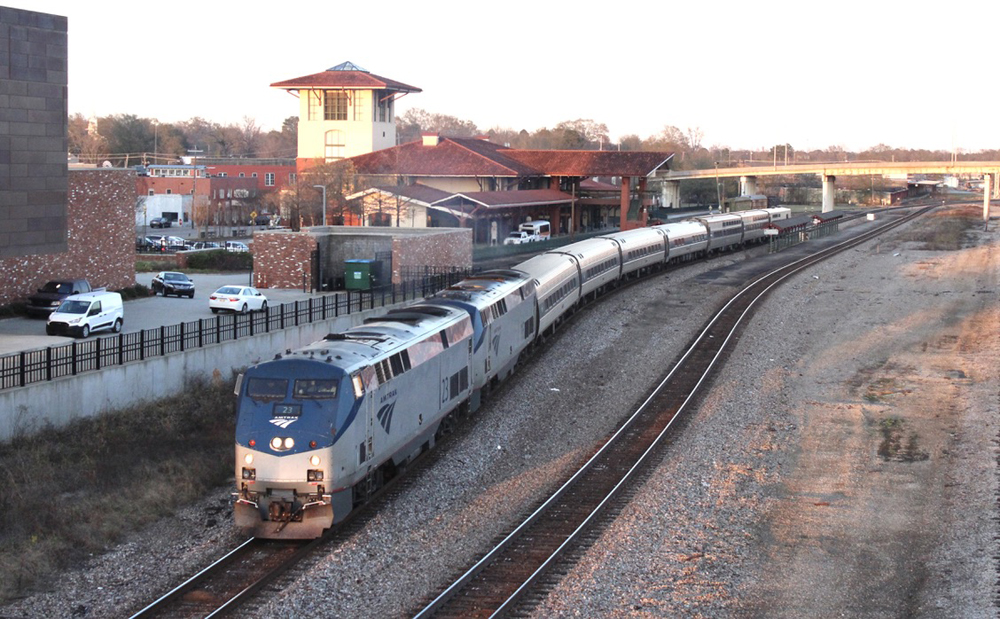
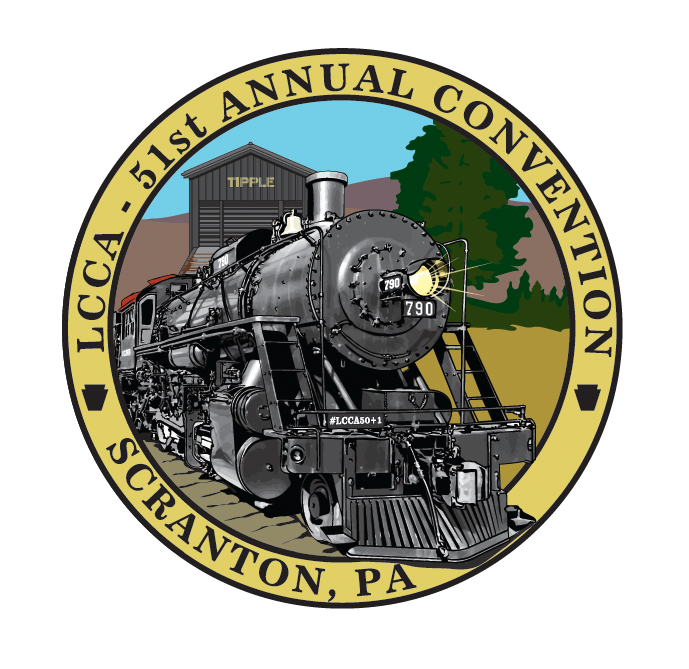
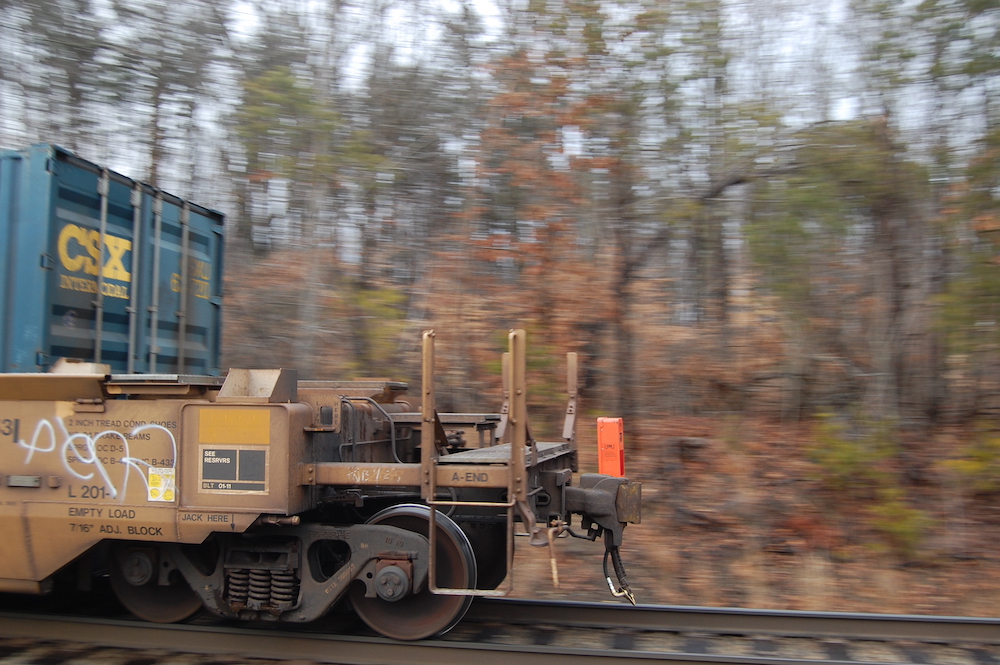
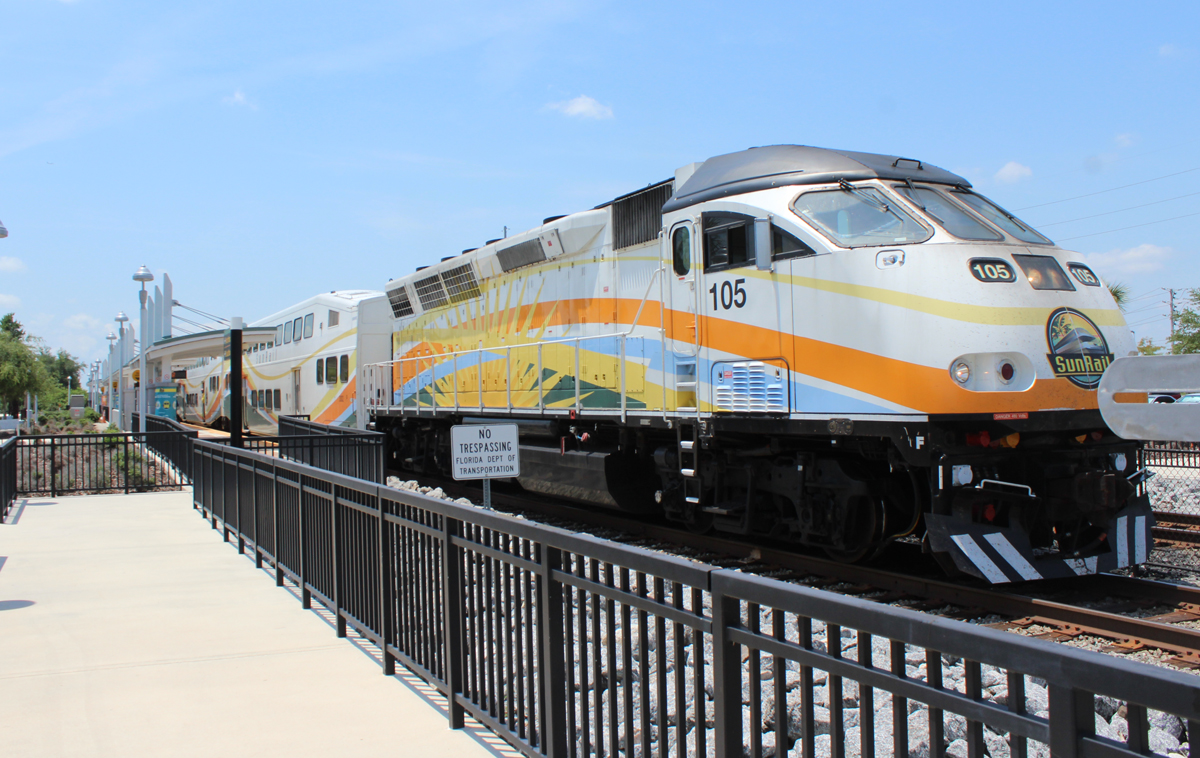




“Um….you know that KCS is already planning another bridge at Laredo/Nuevo Laredo”
Yep, knew that, so does BNSF.
“Mr. Rice, what has BNSF ever done to you? If I may observe, you sound like someone who has a very big chip on their shoulder.”
Nothing. Absolutely nothing. Just calling out noncompetitive behavior. I cheered for BNSF when the locals tried to block their bridge expansion at Cour D’Alene. So no chips.
Sandpoint, not Coeur d’Alene. Or even “Cour D’Alene”
Thanks for the correction.
My take is this plan is to get containers off the boat as fast as possible and onto a railcar. Get the train out of the crowded port area and sort them where they have room to grow. No more switching congestion on the docks while they wait to get enough containers for a particular destination. A container shuttle from port to sort. This would also eliminate some drayage to the inland empire area as a bonus.
Quoting John Rice: “The shortest route from Laredo to the Houston Terminal is via KCS through Robbsville near Corpus Christi. The UP route goes north to the San Antonio market before going east.” Actually, both routes (UP via San Antonio and KCS & KCS operating on UP via Robstown, Bloomington, Victoria, and Rosenberg) are 365 miles from Laredo to Houston. And it really is Robstown, not Robbsville. I don’t know what relevancy this has, especially since the stated goal of the CP-KCS merger is for long haul traffic. From Laredo to Texarkana, KCS is already 153 miles longer than UP, and to Chicago, KCS-CP will be a whopping 350 miles more than UP (and even UP’s alternate routes – which CPKC will not have – are shorter with a better profile.
Mr. Rice, please correct me if I am wrong, but doesn’t KCS (CPKC) own the only rail bridge at Laredo? And it is KCS and UP that own (and control) all the trackage in the Laredo area? So how exactly would BNSF access the Laredo Gateway without building a new main line from Houston to Laredo at an estimated cost of $2 million-plus per track mile? Even BNSF (and Mr. Buffet) have their limits.
BNSF has rights on UP at Brownsville and Eagle Pass. KCS jumped the rates for BNSF bound traffic at Laredo to the point BNSF had to re-route the traffic to Eagle Pass and get to Mexican shippers via Ferromex. This caused BNSF to lose customers and rebuild new ones on Ferromex.
BNSF has been complaining about this for several years as KCS has essentially priced them out of the market and they want a merger condition that the merged entity give them trackage rights to Laredo to stop the price gouging.
The shortest route from Laredo to the Houston Terminal is via KCS through Robbsville near Corpus Christi. The UP route goes north to the San Antonio market before going east and BNSF does not have a trackage agreement for this line.
So the choice for BNSF is really simple, if they don’t want to pay KCS the carriage fees to use Laredo, they can continue to use Eagle Pass at an apparent loss of business, or they can invest in their own Laredo to Corpus Christi route to reach the shared track to Houston Terminal. (130 miles/$260 million) Or offer an offsetting concession to CPKC somewhere else on their network to make it worth their while.
My take is that if it is worth spending $260 million for a route that has positive cash flow for over 30 years, whats the hold up?? BNSF has the capital. If the route is that valuable to them surely they can invest in it.
But see there is the issue with all the traffic between Mexico and the Houston Terminal. No one wants to stick their neck out “too far”. So they drum up these shared track deals and then complain about them when someone wants to use it.
All true but first you never dealt with the issue of who owns the bridge at Laredo!!! Next, you appear to have completely missed the federal regulatory framework here. Please remember the final decision here does not belong to the BNSF or any other US railroad. It belongs to the STB and the EPA. You conveniently assume the STB would approve a new route when several operational routes already exists. (Check the legal record of both the ICC and the STB; they rarely if ever approve new line construction in lieu of trackage or haulage rights.) And even with eminent domain it could years if not decades to assemble the ROW. (As an example, look at all the delays faced by the Texas High Speed Rail Project.) And finally, there is the infamous process known as the Environmental Impact Statement. I assume you are aware of the concept of the “time-value of money”. On that basis your proposed project comes very close to generating a negative cash flow.
Back in the seventies the CNW wanted very badly to build its own line into the Powder River Basis, but it was the ICC that told them to “share” with BN. Nether railroad was happy with the decision but that was the LAW as interpreted by the governing federal regulatory agency.
BNSF can work with the Mexican authorities to get another bridge built. It does take awhile for them to move on such things ( like in Presidio) but they do occur and it is very possible. Yes, I am aware of such requirements and expected it to be included in any arrangement.
All BNSF has to do is raise their finger to start such things, they do it all the time (EPA, EIS, etc) to do that is not a legitimate impediment. You are making somewhat gross assumptions here (unfortunately) that I would expect something immediately.
If the Laredo Gateway is growing as fast as they all say, then wouldn’t it be prudent to start that work now?
The CNW situation is a little different and not exactly apples and apples. CNW was under a large degree of financial stress at the time and didn’t have access to a large degree of capital, nothing close to what BNSF has access to today. For CNW it was more than just a access to Wyoming issue, it was many others like getting appropriate motive power and financing an upgrade to much of their line. The power generating groups wanted 2 carriers for resiliency and so the PTB facilitated that.
Um….you know that KCS is already planning another bridge at Laredo/Nuevo Laredo:
https://www.freightwaves.com/news/kansas-city-southern-set-to-build-75-million-rail-bridge-in-laredo#:~:text=Kansas%20City%20Southern%20ready%20to%20build%20%2475M%20rail,to%20be%20completed%20by%20the%20end%20of%202023.
Part of the reason for the new bridge is the KCS approach on the Laredo side, which includes about 20 grade crossings before getting to the existing bridge, which more-perfectly aligns with the UP.
Mr. Rice, what has BNSF ever done to you? If I may observe, you sound like someone who has a very big chip on their shoulder.
This is a perfect example of why people question BNSF and the whining about the Laredo Gateway and the CPKC merger. If they want to improve traffic through Laredo for themselves, they can certainly go invest in it instead of complaining to the STB and CPKC about it. There is no doubt they have the money.
As for the “waste of diesel” by not directing at the port, actually UP is already forwarding pre-blocked containers up to Salt Lake City, so for BNSF to do so at Barstow is not a stretch. Besides, with California ongoing subsidizing of non-diesel motive power out of the LA Basin, it won’t be long before less & less diesel will be in use overall.
IMO this is long overdue. This ” inernational gateway ” is a fancy name of a classification yard. The gateway results will be the same as what happens at a flat switching or hump yard.
Instead of building trains at the 2 LAX ports most can be accomplished at Gateway.
Now would it be efficient to load a 5 packer at the port and switch it at Gateway hard to say. It might be if the port can load some end of a train IM cars all to the same US IM terminal then maybe so?
The problem of sending international containers to domestic locations is also a question. At least the port with gateway will be able to move containers quickly out of the way. However UP will still have the problem of port sorting that will slow up moving conainers both empty and full. A transload facility built on sorting rail car loads will be more efficient than the present operation.
This implies that all incoming containers destined for the LA area will be routed through Barstow instead of going from the pier directly to their destination. Talk about wasting time and diesel fuel.
Mr. Rittle your arrogance, ignorance and sheer stupidity are just amazing!!! Have you driven on Southern California freeways lately? Most hours of every day they resemble a giant parking lot. If you check the facts about one-third of California’s population lives in the Valley with about another third in the Bay Area. And 70 percent of all imports stay within the state of California. There is a reason why our friend Gene Saroka loves this idea so much.
All containers destined to or from the LA area must be routed through Barstow, but not necessarily yarded there.
This is because BNSF has one route inland to or from the LA Basin and it passes through Barstow. BNSF traffic from the Bay Area also passes through Barstow.
As I read it, this facility is to transload shipborne cargo between the smaller ISO contaners and North American containers, as well as to build through trains where there’s room to do it.
I got to look at a map of the new facility. When ATSF built the current Barstow Yard (replacing the one at the Passenger Station/Harvey House) they rerouted the line from Bakersfield to come in West of the new yard and they included a wye to allow Bakersfield to San Bernardino moves.
The BIG facility will be West of the wye so Eastward traffic will have to turn West to use the new facility.
Interestingly, Southern California Logistics Airport (SCLA) is in nearby Victorville, using the former George AFB.
The true genius of the only privately-owned American railroad at work. The LA Basin is full, and every BNSF terminal land locked, so BNSF goes out to Barstow and expands the intermodal terminal they just opened in 2019 (Premium Service in Containers). So where are all you nattering nitwits of negativism now??? BTW, Bradon K. do you still believe short-haul rail won’t work???
It will be interestiung to see the commercial elements of this plan – who pays for the Ports-to-Barstow poertion, and how it compares with dray costs in the Basin. And who will take advantage of this service.
It may be that JBH is behind this. We shall see.
What I believe is that there’s no existing short-haul intermodal that works. It will be interesting to see what’s different about BIG.
Mr. Fuller, I assume you are aware of the successful short-haul rail operations at the Port of Savannah and the Port of Charleston that support multiple inland port operations in the states of both Georgia and South Carolina. And I’m proud to say that my friend NS Corporate Director of Planning Michael McClellan was the “Godfather” of Inland Port Greer (SC). Michael is the son of another good friend, the legendary late Jim McClellan. It seems genius runs in that family.